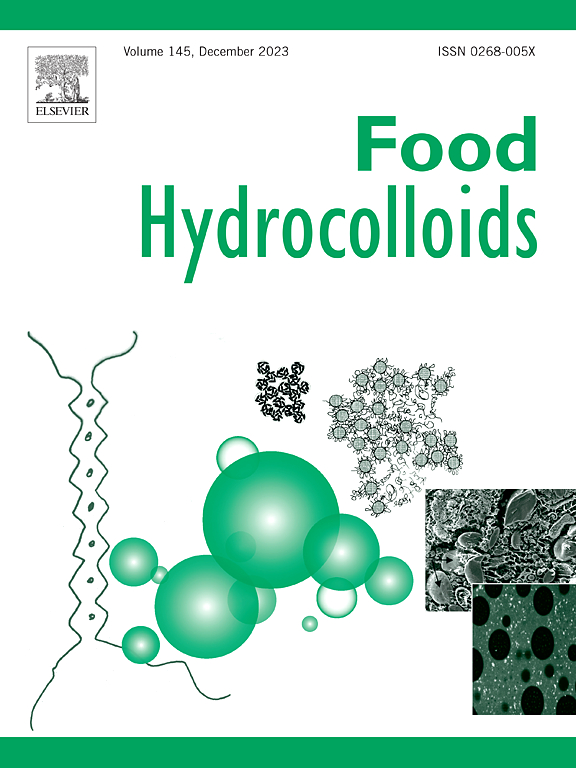Novel imine dynamic response films with grafting phenylalanine onto oxidized starch/pectin matrixes and regulated physiological metabolism of cherry tomatoes
IF 11
1区 农林科学
Q1 CHEMISTRY, APPLIED
引用次数: 0
Abstract
Dynamic response films with efficient, accurate and biodegradable properties greatly contribute to food packaging materials. In this study, phenylalanine was innovatively reversibly grafted onto oxidized starch via imine bonding and blended with Ca2+ and pectin to prepare novel imine dynamic responsive composite films (PO-PE/Ca). The results indicated that the cross-linking and dense structure formed by electrostatic interaction in PO-PE/Ca, and showed excellent thermal stability. The composite films displayed excellent mechanical property (elasticity modulus over 2100 MPa), and the water vapor permeability was 26.4 % lower than that of individual starch films. Additionally, the introduction of benzene rings and imine bonds significantly improved the ultraviolet shielding properties and transparency of the films. The internal imine bonds of PO-PE/Ca could be stimulated by acidic gases of fruit respiration, and constantly released phenylalanine to regulate fruit metabolism. The films effectively maintained fruit quality and significantly promoted phenol content (9.5 mg/100g) of fruits, showing resistance to Botrytis cinerea of cherry tomatoes during 10 d storage. This study provided a novel strategy for the development of dynamic controlled release packaging materials in food preservation.

在氧化淀粉/果胶基质上接枝苯丙氨酸的新型亚胺动态响应膜及其对圣女果生理代谢的调控
动态响应膜具有高效、准确和可生物降解的特性,是食品包装材料的重要组成部分。本研究创新性地将苯丙氨酸通过亚胺键接枝到氧化淀粉上,并与Ca2+和果胶共混,制备了新型亚胺动态响应复合膜(PO-PE/Ca)。结果表明,PO-PE/Ca在静电作用下形成交联致密结构,并表现出优异的热稳定性。复合膜具有优异的力学性能(弹性模量超过2100 MPa),透气性比单一淀粉膜低26.4%。此外,苯环和亚胺键的引入显著提高了薄膜的紫外线屏蔽性能和透明度。果实呼吸产生的酸性气体可刺激PO-PE/Ca内部的亚胺键,并不断释放苯丙氨酸,调节果实代谢。覆膜能有效保持果实品质,显著提高果实酚含量(9.5 mg/100g),在贮藏10 d期间对樱桃番茄灰霉病表现出抗性。该研究为食品保鲜用动态控释包装材料的开发提供了新的思路。
本文章由计算机程序翻译,如有差异,请以英文原文为准。
求助全文
约1分钟内获得全文
求助全文
来源期刊

Food Hydrocolloids
工程技术-食品科技
CiteScore
19.90
自引率
14.00%
发文量
871
审稿时长
37 days
期刊介绍:
Food Hydrocolloids publishes original and innovative research focused on the characterization, functional properties, and applications of hydrocolloid materials used in food products. These hydrocolloids, defined as polysaccharides and proteins of commercial importance, are added to control aspects such as texture, stability, rheology, and sensory properties. The research's primary emphasis should be on the hydrocolloids themselves, with thorough descriptions of their source, nature, and physicochemical characteristics. Manuscripts are expected to clearly outline specific aims and objectives, include a fundamental discussion of research findings at the molecular level, and address the significance of the results. Studies on hydrocolloids in complex formulations should concentrate on their overall properties and mechanisms of action, while simple formulation development studies may not be considered for publication.
The main areas of interest are:
-Chemical and physicochemical characterisation
Thermal properties including glass transitions and conformational changes-
Rheological properties including viscosity, viscoelastic properties and gelation behaviour-
The influence on organoleptic properties-
Interfacial properties including stabilisation of dispersions, emulsions and foams-
Film forming properties with application to edible films and active packaging-
Encapsulation and controlled release of active compounds-
The influence on health including their role as dietary fibre-
Manipulation of hydrocolloid structure and functionality through chemical, biochemical and physical processes-
New hydrocolloids and hydrocolloid sources of commercial potential.
The Journal also publishes Review articles that provide an overview of the latest developments in topics of specific interest to researchers in this field of activity.
 求助内容:
求助内容: 应助结果提醒方式:
应助结果提醒方式:


